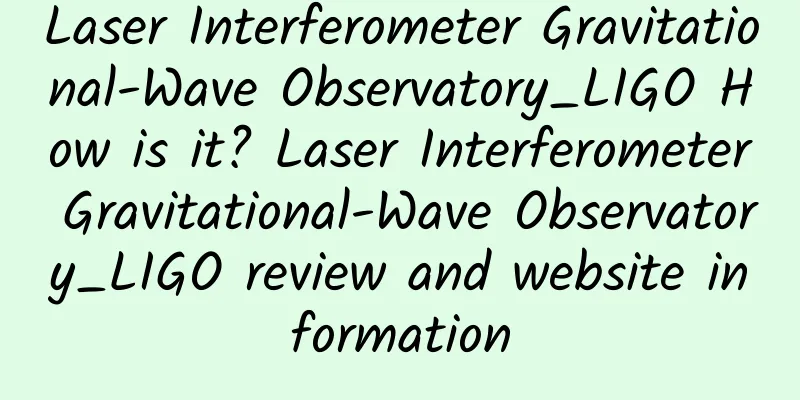Laser Interferometer Gravitational-Wave Observatory_LIGO How is it? Laser Interferometer Gravitational-Wave Observatory_LIGO review and website information

|
What is the Laser Interferometer Gravitational-Wave Observatory? The Laser Interferometer Gravitational-Wave Observatory (LIGO) is a large-scale physics experiment and astronomical observatory that was put into use in 2002. It is located in Hanford, Washington and Livingston, Louisiana, and mainly detects gravitational waves. Website: www.ligo.org The Laser Interferometer Gravitational-Wave Observatory (LIGO) is a large-scale physics experiment and astronomical observatory dedicated to detecting and studying gravitational waves. The construction and operation of LIGO marks an important step in humanity's journey to explore the mysteries of the universe. Gravitational waves are one of the important predictions of Einstein's general theory of relativity. Its detection not only verifies the correctness of this theory, but also provides humans with a new way to observe the universe. This article will introduce in detail the background, principles, construction process, scientific achievements and future prospects of LIGO. LIGO's Background and the Discovery of Gravitational WavesIn 1916, Albert Einstein first predicted the existence of gravitational waves in his general theory of relativity. Gravitational waves are ripples in space-time caused by extreme celestial events in the universe (such as black hole mergers, neutron star collisions, etc.), similar to the ripples caused by throwing a stone on the water. However, because the signal of gravitational waves is extremely weak, scientists have long failed to detect it directly. It was not until September 14, 2015 that LIGO successfully detected the gravitational wave signal from the merger of two black holes for the first time. This major discovery opened a new era of gravitational wave astronomy. The success of LIGO is inseparable from the unremitting efforts of scientists over the past decades. As early as the 1960s, physicist Joseph Weber tried to use resonant rod detectors to detect gravitational waves, but failed. In the 1980s, scientists from the Massachusetts Institute of Technology (MIT) and the California Institute of Technology (Caltech) began to develop laser interferometry technology, laying the foundation for the construction of LIGO. After years of preparation and construction, LIGO was officially put into use in 2002, and in the following years it was continuously upgraded and improved, and finally achieved the successful detection of gravitational waves. Basic principles and technology of LIGOThe core technology of LIGO is laser interferometry. Its basic principle is to use laser beams to propagate in two mutually perpendicular vacuum tubes and detect the tiny space-time distortion caused by gravitational waves through an interferometer. Each LIGO observatory consists of two L-shaped arms up to 4 kilometers long, in which the laser beams propagate back and forth and finally converge on the interferometer detector. When a gravitational wave passes by, the distortion of space-time causes a slight change in the length of the two arms, thereby changing the interference pattern of the laser beam. By accurately measuring this change, scientists can infer the characteristics of the gravitational wave. In order to achieve highly sensitive detection of gravitational waves, LIGO uses a series of advanced technologies. First, the laser beam needs to propagate in an ultra-high vacuum to reduce the interference of air molecules on the beam. Secondly, LIGO uses high-power lasers and highly stable optical components to ensure the stability and accuracy of the laser beam. In addition, LIGO is equipped with a complex seismic isolation system to shield the impact of ground vibrations on the interferometer. Through these technical means, LIGO can detect space-time distortions that are much smaller than the diameter of an atomic nucleus. Construction and Upgrade of LIGOThe construction of LIGO began in the 1990s, funded by the National Science Foundation (NSF) of the United States and jointly led by MIT and Caltech. LIGO consists of two observatories, located in Hanford, Washington and Livingston, Louisiana. The two observatories are about 3,000 kilometers apart and can determine the direction of the source of gravitational waves through triangulation. The original version of LIGO (called "Initial LIGO") was put into use in 2002, but due to insufficient sensitivity, it failed to detect gravitational wave signals. In order to improve detection capabilities, scientists have carried out a large-scale upgrade of LIGO and launched "Advanced LIGO". Advanced LIGO uses more powerful lasers, more sophisticated interferometers and more efficient seismic isolation systems, making its sensitivity more than ten times higher than that of Initial LIGO. Thanks to these upgrades, LIGO successfully detected the first gravitational wave signal in 2015. LIGO's scientific achievements and impactSince the first gravitational wave detection in 2015, LIGO has successfully captured dozens of gravitational wave events. These events include black hole mergers, neutron star collisions, and possible black hole-neutron star mergers. Each detection of gravitational waves provides scientists with valuable data to help them better understand the mysteries of the universe. For example, on August 17, 2017, LIGO and the European Virgo detector jointly detected gravitational wave signals from the merger of two neutron stars. This event not only verified the existence of gravitational waves, but also realized the multi-messenger observation of gravitational waves and electromagnetic waves for the first time, providing a new perspective for studying the origin and evolution of the universe. In addition, LIGO's data also helped scientists verify the correctness of general relativity in strong gravitational fields and provided new clues for exploring quantum gravity theory. The success of LIGO has had a profound impact on astronomy, physics, and the entire scientific community. First, it verified Einstein's general theory of relativity and opened up a new research field, gravitational wave astronomy. Second, LIGO's detection results provide new means for studying extreme celestial bodies such as black holes and neutron stars, promoting the development of astrophysics. Finally, the success of LIGO also demonstrates the importance of international cooperation in scientific research and sets an example for future large-scale scientific projects. What’s next for LIGO?Although LIGO has achieved great success, scientists are not satisfied with it. In the future, LIGO plans to further upgrade its detection capabilities to capture more and weaker gravitational wave signals. For example, LIGO plans to launch the "third-generation LIGO" (LIGO A+) in the late 2020s, and its sensitivity will be several times higher than that of advanced LIGO. In addition, LIGO also plans to work with international partners to build the "Cosmic Explorer", a larger-scale gravitational wave observatory that is expected to be put into operation in the 2030s. In addition to ground-based observatories, scientists are also actively preparing space gravitational wave detection projects. For example, the European Space Agency (ESA) and NASA are working together to develop the Laser Interferometer Space Antenna (LISA), a space gravitational wave detector scheduled to be launched in the mid-2030s. Compared with ground-based detectors, space detectors can detect gravitational wave signals at lower frequencies, thus providing new tools for studying major scientific issues such as supermassive black holes and the Big Bang. LIGO's International Collaboration and Science CommunicationThe success of LIGO is inseparable from the joint efforts of scientists around the world. The LIGO project is jointly operated by an international cooperation team of more than 1,000 scientists and engineers from more than 20 countries. This international cooperation not only promotes the progress of scientific research, but also provides a platform for communication and cooperation for scientists from different countries and regions. In addition, LIGO also attaches great importance to scientific communication and public education. The official website of LIGO (www.ligo.org) provides a wealth of popular science resources, including the basic knowledge of gravitational waves, the working principle of LIGO, the latest scientific achievements, etc. LIGO also regularly holds public lectures, open days and other activities to popularize the knowledge of gravitational waves and astronomy to the public. Through these efforts, LIGO has not only promoted the progress of scientific research, but also stimulated the public's interest and enthusiasm in science. ConclusionThe Laser Interferometer Gravitational-Wave Observatory (LIGO) is an important tool for humans to explore the mysteries of the universe. By detecting gravitational waves, LIGO provides scientists with a new way to observe the universe and promotes the development of multiple disciplines such as astronomy and physics. In the future, with the continuous upgrading of LIGO and the commissioning of a new generation of gravitational wave detectors, human understanding of the universe will continue to deepen and the boundaries of scientific exploration will continue to expand. The success of LIGO is not only a victory for science and technology, but also a manifestation of human wisdom and the spirit of cooperation. |
<<: How is Biology? Biology reviews and website information
>>: Bravo TV - What is it like? Bravo TV - Reviews and website information
Recommend
How to pickle sour peppers
Many people like to eat chili peppers. Some peopl...
The side effects of eating pineapple
Pineapple is a tropical fruit with a sweet and so...
How to grow lucky bamboo How to grow lucky bamboo
Lucky bamboo is also called lucky bamboo, which m...
How to plant lilies How to plant lilies
Lily is a beautiful ornamental plant. Its bulbs c...
How is the Ministry of Education, Youth and Sports of Cambodia? Reviews and website information of the Ministry of Education, Youth and Sports of Cambodia
What is the website of the Ministry of Education, ...
What is the best way to eat Dendrobium? Who is not suitable to eat Dendrobium?
Dendrobium is the most popular health food in lif...
What can't be eaten with soybeans?
Soybeans are a very common bean ingredient in our...
The benefits of eating mashed garlic
When eating hot pot, garlic paste is indispensabl...
What is Roche Applied Science like? Roche Applied Science reviews and website information
What is the website of Roche Applied Science? Roch...
The nutritional value of dragon claw vegetable and the taboos of eating dragon claw vegetable
Dragon claw vegetable is a wild vegetable with ex...
How is the French Voice? French Voice review and website information
What is the website of La Voix de la France? La Vo...
The best fruits to eat at different times of the day
Although fruits are good, according to their char...
What is Munich 1860 like? Munich 1860 reviews and website information
What is the website of 1860 Munich? TSV 1860 Münch...
Blood-enriching porridge for pregnant women
Introduction For mothers, it is very important to...
Production process and materials of five-spice melon seeds
Five-spice melon seeds are a kind of nut snack th...









